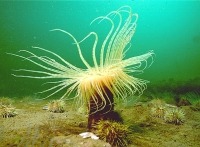
(Photo: Maria-Inez Buzeta and Michael Strong)
Northern Cerianthid
Pachycerianthus borealis
This anemone can be very large - over 20 centimetres in height and diameter. It has a long column. It has two rings of tentacles. These are long and slender. There can be as many as 159 tentacles in the outer ring. It can be white, purple, or brown. The tentacles may be striped.
Authority
Verrill, 1873
Classification Details
Phylum: Cnidaria (Cnidarians); Class: Anthozoa (sea anemones, corals, and sea fans); Subclass: Ceriantharia (tube-dwelling anemones).
Habitat
Present in the western Atlantic from Greenland to Venezuela. Density peaks are at 44 and 45 degrees north, around the Bay of Fundy. Found at depths less than 400 metres. The abundance of cerianthids increases with water temperature up until the temperatures of 15.9°C, at which point abundance begins to decline. Usually found in mud seabeds, although sometimes gravel may be present. It forms a tube from cnidae (see Fun Fact), mucus, and substrate debris.
Diet
This species is a carnivorous suspension feeder. They use their outer tentacles to capture food particles from the water. They then transfer prey to the inner tentacles, which push the prey into the mouth. Prey is stunned by nematocysts (stinging cells) on the tentacles. Its diet includes small crustaceans, such as mysid shrimps and amphipods, and small fish.
Reproduction
Protandric sequential hermaphrodites. This means individuals are born as males and then reproduce as females. Fertilization of eggs occurs in the seawater. There is a long-lived planktonic larval phase. The larvae then settle on the seabed and develop into adult anemones (polyp phase).
Fun Facts
This group of anemones (Order Spirularia) has a type of nematocyst (stinging cell) called ptychocysts. The sticky filaments of these help bind the anemone's tube together.
References
Mariscal RN, Conklin EJ, Bigger CH (1977) The Ptychocyst, a Major New Category of Cnida Used in Tube Construction by a Cerianthid Anemone. Biological Bulletin 152, 392–405. Molodtsova T (2020). World List of Ceriantharia. Pachycerianthus borealis (Verrill, 1873). Accessed through: World Register of Marine Species at: http://www.marinespecies.org/aphia.php?p=taxdetails&id=283816 Accessed 20 online January 2020. Shepard AN, Theroux RB, Cooper RA and Uzmann JR (1986) Ecology of Ceriantharia (Coelenterata, Anthozoa) of the northwest Atlantic from Cape Hatteras to Nova Scotia. Fishery Bulletin 84(3), 627–646.

